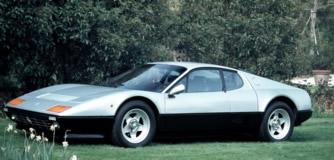|
Externally the new model was recognisable by the re-designed rear bumper and wheels, the side NACA duct finished in black and the body-colour wing mirror. Inside, the classic Connolly leather seats featured a
central wool textile insert and the car was fitted with air conditioning and central locking as standard.
The 512 BBi was introduced at the 1981 Frankfurt Salon, to replace the 512 BB model, the "i" suffix denoting a change from carburettors to fuel injection. Apart from the adoption of fuel injection, in line with the other models in the Ferrari range at the time, there were minor cosmetic and mechanical changes. At the front the plain aluminium egg-crate radiator grille stopped short of the driving lights, which were now exposed in the grille extremities, with small rectangular parking lights mounted in the bumper section above them. At the rear the engine louvre arrangement was modified and a new shroud was provided to the exhaust system, which incorporated hazard warning lights. A new design of door mirror was fitted, changes were made to the interior, including a black spoked steering wheel, and the availability of "Zegna" wool cloth seat centres as an option. The road wheels became the same width front and rear, fitted with Michelin TRX tyres, which had the effect of increasing the front and rear track to 1508mm and 1572mm respectively.
The body was mounted on a 2500mm wheelbase chassis, which had factory reference number F 102 CB 100. All were numbered in the odd chassis number road car sequence, and the construction followed the same principles as
its predecessor of a tubular steel chassis frame with a monocoque central cell. Again as with its predecessor it was available in right or left hand drive form, and again no USA market versions were built. The standard road
wheels were alloy five spoke "star" pattern, with a knock off spinner on a Rudge hub, although legislative requirements in some markets dictated the fitment of a large octagonal hub nut. The wheels covered large
ventilated disc brakes with twin hydraulic circuits, and servo assistance. Independent suspension was provided all round, via wishbones, coil springs, and hydraulic shock absorbers, with twin rear units, together with front and
rear anti roll bars.
The aluminium flat twelve cylinder engine was of the same configuration as its predecessor with a cubic capacity of 4943cc, and 82mm x 78mm bore and stroke, with factory type reference F 110 A 000.
It featured belt driven twin overhead camshafts per bank, with dry sump lubrication and a hydraulically operated clutch. The 512 BBi was fitted with Bosch K-Jetronic fuel injection, and had the same claimed power output as the
carburettor model. The production period ran from 1981 to 1984, when it was replaced by the world market Testarossa model. During that period a total of 1007 examples were produced, in the chassis number range 38121 to 52935.
Engine
Type...................................rear, longitudinal flat-12
Bore/stroke..........................82 x 78 mm
Unitary displacement..............411.92 cc
Total displacement.................4943.04 cc
Compression ratio..................9.2 : 1
Maximum power.....................250 kW (340 hp) at 6000 rpm
Power per litre......................69 hp/l
Valve actuation.....................twin overhead camshafts per bank,
two valves per cylinder
Fuel feed..............................Bosch K-Jetronic injection
Ignition................................electronic, single spark plug per cylinder
Lubrication...........................dry sump
Clutch.................................twin-plate
Chassis
Frame..................................tubular steel
Front suspension....................independent, unequal-length wishbones, coil springs,
telescopic shock absorbers, anti-roll bar
Rear suspension.....................independent, unequal-length wishbones, coil springs,
twin telescopic shock absorbers each side, anti-roll bar
Brakes.................................discs
Transmission.........................5-speed + reverse
Steering...............................rack-and-pinion
Fuel tank..............................capacity 120 litres
Front tyres...........................240/55 VR 415
Rear tyres............................240/55 VR 415
Bodywork
Type...................................two-seater, berlinetta
Length.................................4400 mm
Width..................................1830 mm
Height.................................1120 mm
Wheelbase...........................2500 mm
Front track...........................1508 mm
Rear track............................1572 mm
Weight................................1499 kg (dry)
Performance
Top speed............................280 km/h
Acceleration
0-400 m..............................14.2 sec
0-1000 m.............................25.1 sec
<1980
|
